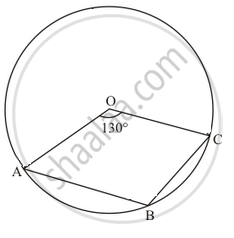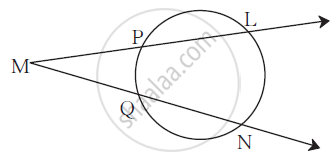Advertisements
Advertisements
प्रश्न
In the given figure, O is the centre of the circle such that ∠AOC = 130°, then ∠ABC =

विकल्प
130°
115°
65°
165°
उत्तर
115°
We have the following information in the following figure. Take a point P on the circle in the given figure and join AP and CP.

Since, the angle subtended by a chord at the centre is twice that of subtended atany part of the circle.
So, `angleAPC = (angleAOC)/2 = 130/2 = 65°`
Since `squareAPBP` is a cyclic quadrilateral and we known that opposite angles are supplementary.
Therefore,
\[ \Rightarrow \angle ABC + 65° = 180° \]
\[ \Rightarrow \angle ABC = 180° - 65° \]
\[ \Rightarrow \angle ABC = 115°\]
APPEARS IN
संबंधित प्रश्न
If circles are drawn taking two sides of a triangle as diameters, prove that the point of intersection of these circles lie on the third side.
ABC and ADC are two right triangles with common hypotenuse AC. Prove that ∠CAD = ∠CBD.
Prove that the circle drawn with any side of a rhombus as diameter passes through the point of intersection of its diagonals.
In any triangle ABC, if the angle bisector of ∠A and perpendicular bisector of BC intersect, prove that they intersect on the circumcircle of the triangle ABC.

In the figure m(arc LN) = 110°,
m(arc PQ) = 50° then complete the following activity to find ∠LMN.
∠ LMN = `1/2` [m(arc LN) - _______]
∴ ∠ LMN = `1/2` [_________ - 50°]
∴ ∠ LMN = `1/2` × _________
∴ ∠ LMN = __________
Prove that the circles described on the four sides of a rhombus as diameters, pass through the point of intersection of its diagonals.
If the two sides of a pair of opposite sides of a cyclic quadrilateral are equal, prove that its diagonals are equal.
In the figure, ▢ABCD is a cyclic quadrilateral. If m(arc ABC) = 230°, then find ∠ABC, ∠CDA, ∠CBE.

If a line is drawn parallel to the base of an isosceles triangle to intersect its equal sides, prove that the quadrilateral so formed is cyclic.
If bisectors of opposite angles of a cyclic quadrilateral ABCD intersect the circle, circumscribing it at the points P and Q, prove that PQ is a diameter of the circle.
